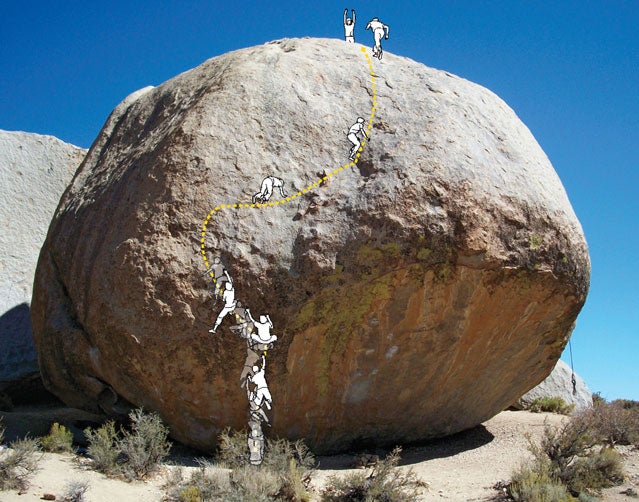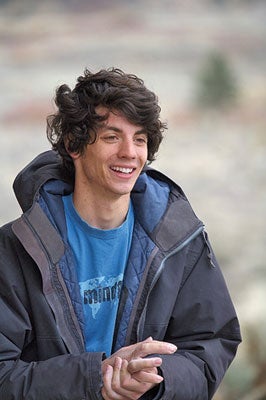You’ve Got a Problem on Your Hands
THE TERM BOULDERING, with its connotations of unroped monkey play on low rocks, scarcely conveys the skill and athleticism required for this century-old climbing discipline, which has exploded in popularity over the past 20 years, thanks in part to the development of high-quality foam-and-nylon crash mats. Top boulderers practice a bouldering route—or “problem”—for days, weeks, or even months, repeatedly falling onto the pads, learning the nuances of every handhold, rehearsing body positions, and then putting it all together to make “the send.” In 2010, two new boulder problems were awarded the highest grade possible: V16. These were the first such problems identified in the U.S.; only a handful of other, equally difficult tests have been proposed elsewhere in the world.
The first of the climbs—the Game, an eight-move line in Colorado, on the underside of a prominent talus block below Boulder Canyon’s Cob Rock—was completed by Daniel Woods on February 10, 2010; it has since been repeated and downgraded to V15. The other, Lucid Dreaming, on the Grandpa Peabody boulder outside Bishop, California, was sent by Paul Robinson on March 30, 2010. His remains the only successful climb, and though the 24-year-old Robinson has said Lucid Dreaming might be only a V15, he’s certain that it’s the hardest thing he’s ever done. Robinson worked on the climb over a three-year period, falling hundreds of times during practice trips made from his home in Boulder, Colorado.
Many people watched Robinson rehearse the route, but he finally nailed the ascent without witnesses or cameras. Any chance he’s lying? No way. Thanks to Robinson’s track record and his frequent presence on the rock, the only doubts have been expressed in a few snarky comments in the blogosphere. Here’s how he pulled it off.
Ěý
Paul Robinson’s V16 route Lucid Dreaming

THE NUMBERS
Boulderers use a different rating scheme than the better-known Yosemite Decimal System, an ascending scale that ranges from 5.0 to 5.15b and marks the difficulty of roped rock-climbing routes. The V scale, codified by John “Verm” Sherman around 1991, is somewhat more fluid—it rates Âindividual moves or sequences, a more subjective animal—and with Ârepeat ascents a problem’s grade can fluctuate until a consensus emerges. (The first and repeat “ascensionists” arrive at the rating based on comparisons with similarly difficult climbs.) Robinson first proposed a V16 for Lucid Dreaming because, as he explained on a blog, it features “by far the two hardest moves I have ever completed”—two single movements, each rated V12/V13, linked one into the next. At the time, Lucid Dreaming had repelled other top climbers, including Chris Sharma and Woods.
THE ROCK
Lucid Dreaming traces the left side of the south face of the 60-foot Grandpa Peabody boulder, the king daddy of dozens of egg-shaped rocks scattered above a dirt track near Bishop called Buttermilk Road. The rock here is quartz monzonite, a punishing stone made up of sharp crystals. The climb moves out on the boulder’s 45-degree-overhanging underbelly, then onto a scoop (rated 5.12) and a low-angle slab (5.9) to the top-out point at 55 feet. The toughest moves come right away, on the belly. Here, Robinson began with a sit start (seated in the dirt) and moved into an upside-down three-finger spike with his right hand. From the spike, he reached left to a microscopic pinch grip—a so-called belief hold just one-sixth of a finger pad wide—from which he leaped to a three-quarter-pad crimp edge, his feet Supermanning away from the overhang. Robinson picked this climb because, while it had already been completed from a higher, standing start, it hadn’t been done from the sit—the portal to the toughest moves. The small, sharp holds also favor Robinson’s style, which climbers call fingery or technical.
1. THE REGIMEN
A problem this hard demands superhuman contact (that is, finger-to-rock) strength, extreme flexibility, precision gymnastic timing, and focus. Robinson, five foot ten with tendons like steel cables, is known for his freakishly strong fingers, his high strength-to-weight ratio (he weighs 130 pounds and can do three one-arm pull-ups with each arm), and his composure. “I had to dig past any sort of concentration and dedication I’d ever had to make this climb a reality,” he says. In the months leading up to the send, Robinson worked on key points like endurance and dynamic movement at the climbing gym. He honed his core muscles—abdominal, oblique, iliacus, and psoas—on the 55-degree overhang at the Colorado Athletic Training School in Boulder. He also did 100 sit-ups and 50 push-ups after each gym session.
2. THE REHEARSAL
“The holds are so ingrained that they’re definitely something I’ll never forget,” says Robinson, referring to the motor programming he developed for the crux pinch and crimp, three moves into the climb. To optimize his feel he stacked three crash pads, which allowed him to reach up and fondle the rock. “I would memorize the holds, get into position on the pads, put one foot on, and mock-go to the pinch or mock-go to the crimp,” he says. Because he couldn’t risk a fall on the 5.12 traverse, which begins 25 feet off the ground, he practiced this section five times on rope. On his successful ascent, he placed a half-dozen crash pads below the boulder. Though these protected the hardest climbing down low, they were of little value as he went higher.
3. THE SKIN
In bouldering, skin-to-rock friction is everything, so you have to preserve your epidermal layers. Robinson won’t let his hands get wet on climbing days, knowing that his skin soaks up moisture and becomes prone to tearing. To prevent cracking, he uses antibacterial cream but not lotion. Another factor: atmospheric conditions. Too hot or humid and your skin forms a sweat layer; too cold or dry and it gets slick. When Robinson did Lucid Dreaming, it was 40 degrees out, with light humidity from a gathering storm. He says the tackiness helped on the pinch, which has a glassy finish.
4. THE DREAM
Predawn on March 30, Robinson was asleep at his hotel in Bishop, and for the second night running he was having the same dream. He was in his hometown of Moorestown, New Jersey, and his father, Chip, who’d died in 2009, sat watching him train on the garage-wall “woodie.” But now the wall held only terrible pinch grips. Robinson jolted awake, checked the weather report, called friends to go climbing (all were asleep), and then drove solo up to Grandpa Peabody.
5. GAME TIME
Robinson parked, hiked up the hill with his crash pads, warmed up on a set of holds around the corner, and then tried Lucid Dreaming alone, minus the 20-odd onlookers usually gathered below the popular boulder. The first time, he grabbed the pinch poorly, dropping off automatically, as he’d done so many times before to save precious skin. On his next effort, he grabbed the pinch “decently well” but only half-stuck the crimp, swinging out and falling.
6. THE EXECUTION
Robinson rested, dipped his hands into his oversize chalk pot, and then tried a third time, climbing smoothly and snagging the pinch perfectly. His mind, he says, “shut off for a little bit,” and muscle memory took over as he cocked for the dynamic leap, or “dyno,” to the crimp. The dyno is what climbers call a low-percentage move—a precise coordination of physics that comes together only one time in several—and it had become Robinson’s nemesis. Through trial and error, he’d learned that if he didn’t jump hard enough, his fingers couldn’t settle onto the hold, but that if he jumped too violently he would pendulum off and shred his fingertips. This time Robinson leaped just right, slightly bending his right arm when he caught the crimp and using his core to hold the swing at the apex for a half-second longer. He swung back in, put his feet on, and continued up the route.
7. THE VICTORY
Now Robinson climbed through middling-hard crimp moves to a rest before the 5.12 traverse. Because it was so cold, his hands weren’t even sweating. “I got the mini-jug [rest], composed myself, looked at what I had to do, and gunned it,” says Robinson. “There was no going back—it was do it, get to the top, and that was all I could think about.” A drizzle fell on the final slab as a storm socked in the valley. Alone on top, the climber gave a victory whoop, took in the surrounding rockscape, and then rappelled down a rope he’d left tied there. Back on the ground, Robinson called his friends; awake now, they drove up to congratulate him.


